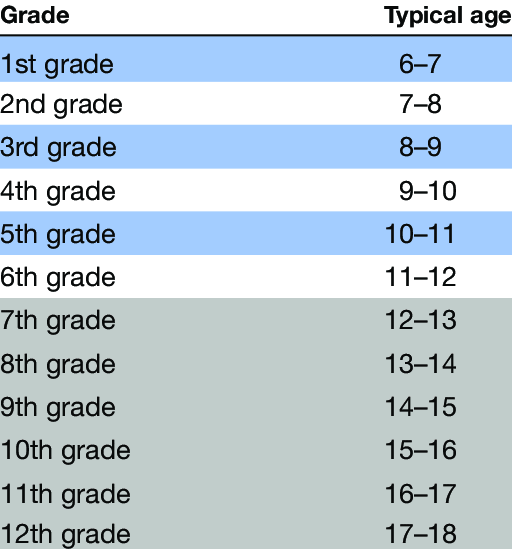The typical age range for a 9th grader is around 14 to 15 years old. However, this age range can vary based on several factors, including when a child was born in relation to the school cutoff date and if they started school at the usual age for their grade level.
Students who turn 14 before the cutoff date for school enrollment, which is often around September 1st, may enter 9th grade at the age of 14. Conversely, those who have their birthdays after the cutoff date might enter 9th grade at 15 years old.
Additionally, some students might have entered school earlier or later than the standard age, impacting their age when they reach the 9th grade. This variability in ages is due to differences in state regulations regarding school entry age and individual choices made by parents or guardians about when to start their child’s formal education.
How old are typical 9th graders?

The typical age range for 9th graders falls between 14 to 15 years old. This age bracket represents the majority of students entering 9th grade across the country. However, it’s crucial to note that individual ages within this range can vary due to multiple influencing factors.
Birthdate Relative to School Enrollment Cutoff
The age of a student entering 9th grade can be significantly affected by their birthdate in relation to the school enrollment cutoff date. For instance, if a school’s cutoff date is September 1st, students born in September would typically be the oldest in their grade, while those born in August might be among the youngest. This discrepancy in age due to birth dates impacts when students start a particular grade level.
Variations Due to Individual School District Policies
Different school districts might have varying policies regarding enrollment age or grade placement, leading to differences in the ages of 9th graders. Some districts might offer more flexibility in grade placement based on academic performance or other criteria, resulting in variations in age among students within the same grade.
Parental Decisions on School Entry Age
Parents or guardians might make decisions regarding their child’s school entry age, potentially choosing to delay a child’s entry into kindergarten or start them earlier than usual. Such decisions can affect the age at which a student reaches 9th grade, contributing to age differences within the grade level.
Academic Readiness and Skipping or Repeating Grades
Academic readiness, along with decisions to skip or repeat grades, significantly impacts a student’s age in 9th grade. Some students may advance a grade due to exceptional academic performance or skip a grade for various reasons, while others might repeat a grade to improve academic skills. These choices can lead to significant age differences among 9th graders.
What factors create age differences among 9th graders?

These scenarios illustrate how the interplay of birthdate relative to school enrollment cutoffs and individual educational journeys can lead to variability in the ages of 9th graders.
Students Entering at 14 Years Old:
Birthdays Before the School Enrollment Cutoff
Students who celebrate their birthdays before the school enrollment cutoff date, which often falls around September 1st in many districts, typically enter 9th grade at the age of 14. These students may be among the oldest in their grade level due to being closer to the cutoff date.
Starting School at the Standard Age
Students who start school at the standard age without skipping or repeating grades are likely to enter 9th grade at 14 years old. They follow the regular academic progression, advancing through each grade level, and reaching 9th grade at the typical age for their peers born within the same timeframe.
Students Entering at 15 Years Old
Birthdays After the School Enrollment Cutoff
Those born after the school enrollment cutoff date (e.g., born in September in districts where the cutoff is September 1st) might enter 9th grade at the age of 15. These students could be among the youngest in their grade level due to their birthdate falling after the enrollment cutoff.
Delayed School Entry or Other Educational Paths
Some students might experience delayed school entry, perhaps due to various reasons such as health concerns, parental decisions, or participation in alternative educational paths like homeschooling. Delayed entry can result in students entering 9th grade at 15 years old, impacting their age relative to their peers.
How do state regulations impact the age of 9th graders?
These state-specific regulations and regional differences provide insights into the diverse educational landscapes across regions or states.
Impact of State-Specific Enrollment Cutoff Dates
State-specific enrollment cutoff dates play a pivotal role in determining the age of students entering particular grade levels. These cutoff dates, often set by state educational authorities or school districts, determine the eligibility criteria for children to enroll in school at a certain age.
Variability Across States
Different states may have varying enrollment cutoff dates. For instance, one state might have a cutoff date of September 1st, meaning students must reach a certain age by that date to enroll in a specific grade level.
Another state might have a different cutoff date, such as October 1st or a different month entirely, leading to differences in the age distribution of students within the same grade level across states.
Regional Variations in School Entry Age Norms
Within a country or region, school entry age norms can vary based on local policies, cultural factors, and educational philosophies. Some regions or communities may prioritize earlier school entry, encouraging parents to enroll their children at younger ages, while others might adopt a more flexible approach, allowing delayed entry or alternative educational paths.
Cultural attitudes, socioeconomic conditions, and community beliefs also influence school entry age norms. Some communities may value early education and push for children to start school at younger ages, while others might prioritize readiness and maturity, resulting in children starting school at older ages.
Examples of States with Different School Enrollment Regulations
States in the U.S. such as California, Texas, New York, and Florida may have differing cutoff dates for school enrollment. For instance, California’s cutoff date might be different from New York’s, impacting when children born around the cutoff dates start school and subsequently enter specific grade levels.
In addition, some states might offer more flexibility in enrollment age or grade placement, allowing for exceptions or accommodations based on individual circumstances. These policies can result in diverse age distributions among students within the same grade level across different states.
FAQ’s
How old are 7th graders in America?
Typically, 7th graders in America are around 12 to 13 years old.
How old is a 12th grader?
A 12th grader in America is usually around 17 to 18 years old.
How old is a 1st grader?
A 1st grader in America is usually around 6 to 7 years old.
How old is a 5th grader?
A 5th grader in America is typically around 10 to 11 years old.
How old is a 2nd grader?
A 2nd grader in America is generally around 7 to 8 years old.
How old is a 6th grader?
A 6th grader in America is usually around 11 to 12 years old.
Final Words
In summary, most 9th graders in the US are around 14 to 15 years old. Some start at 14 if their birthday is early or they follow the regular school path. Others start at 15 due to a late birthday or starting school later. Different rules in each state affect when kids begin school and join specific grades. Some places have different rules about when kids can start school. This makes the ages of 9th graders different across the country. Understanding these rules helps us see why kids in the same grade can be different ages. It’s important to think about these rules and how they affect each student.

